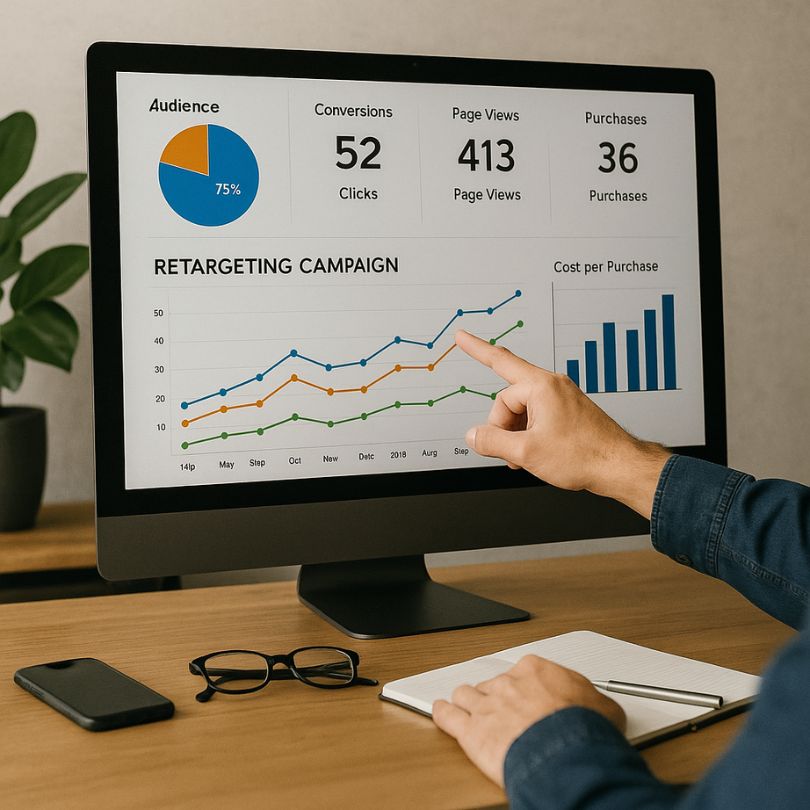
Retargeting Campaigns: How to Build High-ROI Remarketing That Converts

Retargeting campaigns are one of the most reliable, cost-efficient ways to turn warm attention into measurable revenue. If you have traffic coming from SEO, paid search, social, or partnerships, retargeting captures the people who showed intent but didn’t complete a conversion, bringing them back with the right message at the right moment.
At its core, retargeting (also called remarketing) works by identifying an audience that has interacted with your brand—visited a page, added to cart, watched a video—and then serving tailored ads to that audience across channels. Major ad platforms provide robust remarketing tools; for example, Meta’s resources on retargeting explain how to reach people who already know your business and nudge them toward action.
When done correctly, retargeting multiplies the ROI of your top-of-funnel investments by reclaiming otherwise lost demand. When done poorly, it can waste budget, overfrequency users, and erode brand goodwill. The difference comes down to the strategy: audience segmentation, message-matching, frequency control, and disciplined measurement.
Before you set live a single ad, think about the experience you’re creating. Your creative should feel like a continuation of the user’s last interaction, not a generic restart. Competitive research helps here—see what angles, formats, and hooks are common in your space. Tools that surface creative patterns and formats for channels like push ads can accelerate your learning; exploring push ad intelligence can inspire variations that fit your audience and funnel stage.
Step-by-Step Framework for Building Retargeting Campaigns
1) Define success and guardrails
Start with crystal-clear business goals and constraints. Which conversion is the primary KPI (purchase, qualified demo, subscription)? What secondary actions signal quality (checkout start, time on site, add-to-wishlist)? Establish target CAC/ROAS or cost-per-lead, plus minimum volume thresholds. Set guardrails: acceptable frequency per user per week, maximum lookback window, and geo/language constraints. These become the rules that guide every execution decision later.
2) Audit tracking, privacy, and consent
Verify your pixel and conversion APIs are firing, deduplicated, and mapped to the right events. Implement server-side events where possible to mitigate browser signal loss. Confirm consent management covers remarketing cookies and that your privacy policy explains data use. Inaccurate tracking yields flawed optimization and misleading ROAS—fix this before scaling.
3) Segment audiences by intent and recency
Create distinct audiences by both behavior and time window. For example: product viewers (1–3 days, 4–7 days, 8–14 days), cart abandoners (1–3, 4–7, 8–14), checkout abandoners (1–7), and past purchasers (for cross-sell). Recency buckets matter because intent decays quickly. A user who abandoned today should see a stronger offer than one who bounced two weeks ago. Exclude converted users from lower-funnel sequences to avoid waste and fatigue.
4) Map creative, offers, and landing pages to each segment
Message match boosts conversion. For cart abandoners, lead with urgency and social proof. For product viewers, emphasize value props and FAQs that reduce friction. Use dynamic product ads for catalogs so the creative reflects what the user actually viewed. Align landing pages to the next best action—not a generic homepage. If you claim “15% off for 48 hours,” the landing page must reinforce that offer with a clear call to action.
5) Choose channels and formats
Meet users where they spend time. Mix and match: Meta Advantage+ catalog for commerce, Google Display/YouTube for scale, search remarketing lists (RLSA) for high-intent queries, and programmatic for broader reach. Consider CRM retargeting via email and SMS for owned channels, and test push, in-app, and short video placements. Always align format to message—FAQ carousels for objection handling, testimonials for trust, short videos for product “aha” moments.
6) Build your campaigns with structural clarity
Organize campaigns by funnel stage and recency window. Within each, group audiences with similar intent to simplify learning. Keep naming conventions consistent so reporting is intelligible: RET|Stage-Cart|Win-1-3|Country-US|Creative-Type-UGC|Offer-10off. Apply exclusions methodically to prevent overlap. Use frequency caps and impression-based pacing to reduce overexposure, especially in small audience pools.
7) Budget allocation and bidding
Allocate budgets proportional to audience size and expected conversion rate. Short recency windows are small but high intent—give them sufficient budget to maintain reach. Test bid strategies: value-based bidding where event values are reliable, or tCPA/tROAS for steady goals. Avoid starving learning by splitting budget too thinly across many micro-segments; consolidate where performance is similar.
8) Craft creative that feels personalized
Use modular creative: hook, proof, value prop, CTA. Rotate variations to combat ad fatigue. Pull copy from reviews and support transcripts to mirror real customer language. For B2B, tailor by role and pain: operators want speed and reliability; finance wants ROI and risk reduction. Keep visuals congruent with the destination page to reduce bounce and increase perceived relevance.
9) Offers that respect margin
Discounts can be powerful but blunt. Try alternatives: free shipping thresholds, bundles, extended trials, onboarding sessions, or bonus content packs. For high-consideration products, offer risk-reduction (money-back guarantees) and friction-reduction (concierge setup). Use progressive offers—start with value messaging, escalate to soft incentives, and reserve strongest discounts for the most recent abandoners.
10) Measurement and attribution discipline
Standardize UTM parameters so you can audit performance across analytics, ad platforms, and your data warehouse. Align conversion windows to your actual buying cycle. Run periodic geo or audience-level holdouts to estimate incrementality (the true lift attributable to retargeting). Beware double counting—retargeting often intercepts users who would have converted organically. Lift tests keep you honest.
11) Optimization cadence
Operate on a weekly rhythm. Refresh winners into new variants, pause creatives with high frequency and falling CTR, and reallocate budgets toward higher-lift segments. Monitor path-to-conversion reports, not just last-click metrics. Identify creative decay: when CTR drops >30% week-over-week, refresh the hook or proof asset while preserving the core offer.
12) Scale with automation—without losing control
Use rules to protect efficiency: pause ad sets when CPA exceeds threshold after a minimum spend, cap frequency at the segment level, and alert when audience size falls below reach targets. Automations don’t replace judgment; they safeguard your time so you can focus on hypothesis-driven tests.
Practical Audience Blueprints
- Cart Abandoners (1–3 days): Social proof + urgency. Offer free shipping or a modest first-purchase incentive. Frequency cap tightly (e.g., 2–3/week).
- Product Viewers (4–7 days): Objection handling carousel: price, fit, returns, testimonials. Invite to compare or view a buyer’s guide.
- Category Browsers (8–14 days): Feature benefits and use cases; introduce a quiz or finder to direct them back to the right product.
- High-Intent Content Viewers (B2B): Promote a case study, ROI calculator, or live demo invite. Swap hard CTAs for value-first follow-ups.
- Past Purchasers (30–90 days): Cross-sell complementary items or replenishment reminders. Exclude recent purchasers to avoid churn-driving overfrequency.
Copy and Creative Formulas That Work
- Problem → Proof → Promise → CTA: Name the friction, show evidence (rating, review snippet), promise outcome, then invite action.
- “What You Missed” Recap: Summarize the value of the product page they visited; add a GIF showing the key feature in action.
- Risk-Reversal: Emphasize guarantees, easy returns, or “cancel anytime.”
- Dynamic Relevance: Use catalog feeds so creative reflects the exact item or category they viewed.
Common Pitfalls to Avoid
- Audience overlap: Forgetting exclusions creates bidding wars between your own ad sets and excessive frequency.
- One-size-fits-all creative: Cart abandoners and casual browsers need different messages and offers.
- Overreliance on discounts: Train customers to wait; use value and experience levers first.
- No incrementality testing: ROAS may look great while net lift is minimal. Run holdouts.
- Stale sequences: Recency buckets need tailored pacing and creative refreshes.
Quick Start Checklist
- Define KPIs, frequency caps, and lookback windows.
- Verify pixel/CAPI events and consent coverage.
- Build audiences by behavior and recency; set exclusions.
- Draft creative mapped to each segment with aligned landing pages.
- Choose channels and placements that fit your messaging.
- Launch with clean naming conventions and adequate budgets.
- Measure with UTMs, aligned conversion windows, and periodic holdouts.
- Optimize weekly; refresh creatives proactively.
Conclusion
When thoughtfully designed, retargeting campaigns act like a concierge guiding warm prospects to the next best step. Segment by intent and recency, align creative to the user’s last interaction, control frequency, and measure lift—not just platform-reported ROAS. Keep learning from your market, and cultivate varied formats and offers so your message stays fresh. If you’re expanding your content engine and looking for new ways to engage audiences mid-funnel, consider experimenting with audio; this guide on affiliate podcasting can inspire formats that pair nicely with remarketing sequences and nurture flows.